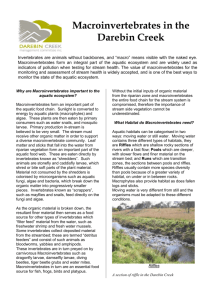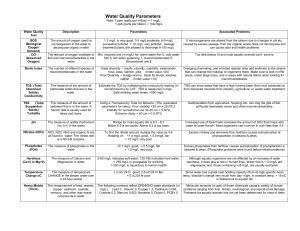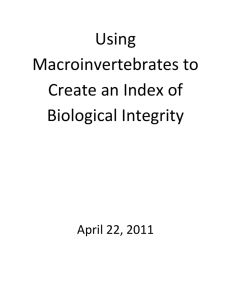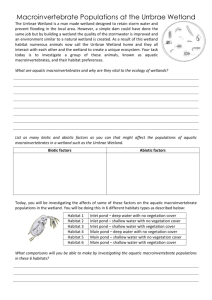An investigation into biodiversity through macroinvertebrates and
advertisement
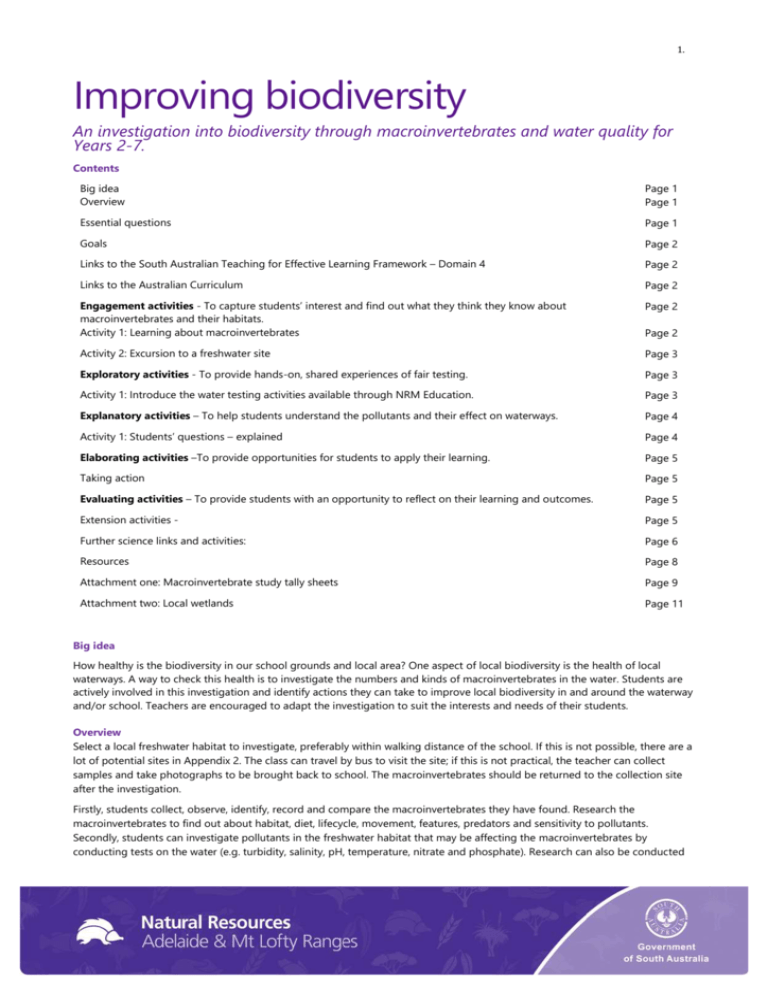
1. Improving biodiversity An investigation into biodiversity through macroinvertebrates and water quality for Years 2-7. Contents Big idea Overview Page 1 Page 1 Essential questions Page 1 Goals Page 2 Links to the South Australian Teaching for Effective Learning Framework – Domain 4 Page 2 Links to the Australian Curriculum Page 2 Engagement activities - To capture students’ interest and find out what they think they know about macroinvertebrates and their habitats. Activity 1: Learning about macroinvertebrates Page 2 Activity 2: Excursion to a freshwater site Page 3 Exploratory activities - To provide hands-on, shared experiences of fair testing. Page 3 Activity 1: Introduce the water testing activities available through NRM Education. Page 3 Explanatory activities – To help students understand the pollutants and their effect on waterways. Page 4 Activity 1: Students’ questions – explained Page 4 Elaborating activities –To provide opportunities for students to apply their learning. Page 5 Taking action Page 5 Evaluating activities – To provide students with an opportunity to reflect on their learning and outcomes. Page 5 Extension activities - Page 5 Further science links and activities: Page 6 Resources Page 8 Attachment one: Macroinvertebrate study tally sheets Page 9 Attachment two: Local wetlands Page 11 Page 2 Big idea How healthy is the biodiversity in our school grounds and local area? One aspect of local biodiversity is the health of local waterways. A way to check this health is to investigate the numbers and kinds of macroinvertebrates in the water. Students are actively involved in this investigation and identify actions they can take to improve local biodiversity in and around the waterway and/or school. Teachers are encouraged to adapt the investigation to suit the interests and needs of their students. Overview Select a local freshwater habitat to investigate, preferably within walking distance of the school. If this is not possible, there are a lot of potential sites in Appendix 2. The class can travel by bus to visit the site; if this is not practical, the teacher can collect samples and take photographs to be brought back to school. The macroinvertebrates should be returned to the collection site after the investigation. Firstly, students collect, observe, identify, record and compare the macroinvertebrates they have found. Research the macroinvertebrates to find out about habitat, diet, lifecycle, movement, features, predators and sensitivity to pollutants. Secondly, students can investigate pollutants in the freshwater habitat that may be affecting the macroinvertebrates by conducting tests on the water (e.g. turbidity, salinity, pH, temperature, nitrate and phosphate). Research can also be conducted 2. on these pollutants to assist students in explaining the effect they have on waterways. Further investigation can be conducted to find out how these pollutants get into the waterway by participating in Gutter Guardians. Click here to view the Gutter Guardians resource. Finally, students can discuss, plan, justify, undertake and evaluate actions they can take to improve local biodiversity in and around the waterway and/or school. Essential questions What are catchments? What effects water quality? How can water quality be tested? What actions can we take to support healthy ecosystems and improve biodiversity? Goals Students will understand Students will know The concept of a catchment The concept of an ecosystem What affects water quality What actions can be taken to support healthy waterways Students will be able to Identify some macroinvertebrates Take action to improve local biodiversity Links to the South Australian Teaching for Effective Learning Framework – Domain 4 Personalise and 4.1 build on learners’ 4.2 connect learning to 4.3 apply and assess connect learning understandings students’ lives and learning in authentic aspirations contexts 4.4 communicate learning in multiple modes Links to the Australian Curriculum - (teachers to determine specific links for year levels) Learning Areas Science English Mathematics Geography Cross-curriculum priorities Sustainability OI 2. All life forms, including human life, are connected through ecosystems on which they depend for their wellbeing and survival. General capabilities Literacy Numeracy OI 7. Actions for a more sustainable future reflect values of care, respect and responsibility, and require us to explore and understand environments. Information and communication technology (ICT) capability Critical and creative thinking OI 9. Sustainable futures result from actions designed to preserve and/or restore the quality and uniqueness of environments. Personal and social capability Ethical behaviour Engagement activities - To capture students’ interest and find out what they think they know about macroinvertebrates and their habitats. Activity 1: Learning about macroinvertebrates Duration: 1- 1.5 hours Materials: A4 coloured, laminated pictures of macroinvertebrates (can be downloaded by clicking here) 1. Students have a dictionary race to find out the meanings of biodiversity, catchment, ecosystem, habitat, and macroinvertebrates. Discuss the meanings and ask them to identify how these concepts are all connected. Draw a mind map to represent their ideas. 2. 3. Distribute one A4 picture of macroinvertebrates to each student. Students discuss the pictures in groups. Find out what they know about macroinvertebrates, where they might live, how they are connected to each other and any other related information. 3. 4. 5. Discuss similarities and differences. Ask one student to stand and show their picture. Ask others to join the student if they think that their creature has any similar characteristics. Continue activity until all have been grouped. Students in new groups to discuss similarities and differences. 6. Ask students to write down any questions they have about macroinvertebrates. 7. Tell them that the macroinvertebrates all live in the same environment and ask them to suggest where. (A yabby is a good indicator that it is a freshwater environment.) List the freshwater environments e.g. river, creek, pond, dam, wetland. 8. Connect the freshwater environments to the concepts of biodiversity, a catchment, ecosystems and habitats. 9. Ask them to discuss any characteristics they think might help the macroinvertebrates survive in the freshwater environment. 10. Use the Habitat Zone Series of posters for students to identify the habitat of their macroinvertebrate. Record what they have discovered and share with other students. Click here to view the posters. 11. Using a map of the local area identify the various habitats. Ask students if they have explored any of these places and what they found. Discuss the positive and negative impacts of people on these places and the animals that live there (e.g. introduced plants and animals, rubbish, landcare groups, revegetation projects). 12. Ask students if they know the word ‘sustainability’ and what it means. Identify people’s role in taking action to preserve or restore the quality and uniqueness of local environments into the future. Activity 2: Excursion to a freshwater site Duration: collecting macros = 1 hour. Materials: Copies of tally sheets (attachment one) for each child, clipboards, pencils. Borrow a free macro monitoring kit from NRM Education which contains 10 nets, macro-viewers, trays, and other useful equipment. Ideally you want one net per two students or make your own nets and use 6 -7 white ice-cream containers, plastic spoons and print off the macro identification charts OR purchase nets from a known supplier. If taking back to the classroom from a waterway off-site you will need two buckets with lids to transport (lids are essential as they will spill in vehicle). Macroinvertebrates must be returned to the site. Note: If you are new to water testing click here to view an 8 minute video on techniques. Some local sites are listed as Appendix 2. 1. 2. 3. 4. 5. In groups of 3 or 4, catch, identify and record macroinvertebrates in the waterway. It is useful to have 3 or 4 parents along to help with safety and recording what is found. Ask students to record the condition of the surrounding area (e.g. weediness, rubbish, new plants). Take results back to school and record in graph form. Discuss the groupings on the identification sheet and what this means (e.g. sensitive and tolerant). Colour the graph according to the sensitivity of the macroinvertebrate (e.g. very sensitive = red, sensitive = yellow, tolerant = green, very tolerant = blue - as featured on ID Chart). Discuss findings and why only a few or no very sensitive macroinvertebrates were found. Discuss if this relates to the condition of the surroundings. Ask the students to record any questions they have. Here the students should come up with the idea that something might be wrong with the water causing the sensitive macroinvertebrates to die. They will probably suggest that the water could be polluted as well as other ideas so guide them to thinking, “how can we find out?” TIP: Undertake this activity at different times of the year as well as before and after storm events as the results will be very different and serve as a good discussion point. TIP: NRM Education can train students/teachers/parents on how to undertake this activity provided the school is an AuSSI-SA school and has plans in place to utilise the training on other within the school community. Question for students: “How can we find out if something is in the water that could be effecting the macroinvertebrates?” Introduce the water testing kits, discussing the tests and what the results will mean for aquatic life. Exploratory activities - To provide hands-on, shared experiences of fair testing. Activity 1: Introduce the water testing activities available through NRM Education. 4. Test Description Turbidity Opacity or muddiness caused by particles of extraneous matter; not clear or transparent. In general, the more material that is suspended in water, the greater is the water's turbidity and the lower its clarity. pH A measure of acidity (or alkalinity). All animals and plants are adapted to specific pH ranges, generally between 6.5 and 8.0. If the pH of a waterway or waterbody is outside the normal range for an organism it can cause stress or even death to that organism. Salinity measures the salt content in water and can be measured using an ECM (Electric Conductivity Meter). How hot or cold the water is. Aquatic species have evolved to live in water of specific temperatures. If Temperature the water becomes colder or warmer, the organisms do not function as effectively, and become more susceptible to toxic wastes, parasites and diseases. With extreme temperature change, many organisms will die. Changes in long-term temperature average may cause differences in the species that are present in the ecosystem. The volume of water that passes through a passage of any given section in a unit of time. When there Flow is little water in the waterway (low flow) sediment settles quickly to the bottom, sections of the stream will become semi-stagnant resulting in low dissolved oxygen concentrations, algal growth will increase if there is adequate light, leading to algal blooms, and salinity and water temperature may increase to values that effect the biota in the waterway. Adapted from http://www.waterwatch.org.au/publications/module4/ Salinity Optional activity The following tests are more beneficial for indicating pollution in the water that could be effecting the macroinvertebrates, but the testing equipment is no longer part of the kit. Click here to see where the tests can be purchased from. Test Description Nitrate An element that is essential for all forms of life. The element nitrogen is recycled continually by plants and animals, and is present in freshwaters at higher concentrations than phosphate. Phosphate Phosphates available to plants and animals are called orthophosphates. Plant growth is limited by the availability of dissolved orthophosphate. A sudden increase in orthophosphate in inland waters can stimulate great increases in the growth of algae, particularly, as well as other aquatic plants. Algal blooms potentially produce toxins and also can cause large deficits of dissolved oxygen. Dissolved oxygen (advanced training required) A measure of the quantity of oxygen present in water. Oxygen is essential for almost all forms of life. Aquatic animals, plants and most bacteria need it for respiration (getting energy from food), as well as for some chemical reactions. The concentration of dissolved oxygen is an important indicator of the health of the aquatic ecosystem. Persistently low dissolved oxygen will harm most aquatic life because there will not be enough for them to use. Adapted from: http://www.waterwatch.org.au/publications/module4/ Conduct the above tests on the water, record your results. Discuss the results and draw a conclusion about the health of the water. Explanatory activities – To help students understand the pollutants and their effect on waterways. Activity 1: Students’ questions – explained Document the questions generated by students from their water testing. Questions may include: What is …. turbidity/pH (etc)? What effect do they have on freshwater environments? How does ….. turbidity/pH (etc) affect the macroinvertebrates? How do these pollutants get into the water? Students in groups research their questions and share and discuss the results of their research. 5. Elaborating activities –To provide opportunities for students to apply their learning. Taking action: Having looked at biodiversity through the health of the waterway and surroundings, discuss with students the values of caring, respect and responsibility and identify ways to take action to preserve or improve local biodiversity. Invite an NRM Education officer (link) to the discussion. They will be able to provide practical ideas for students to consider. Promote the actions with other students and the community to seek support and undertake the improvements. Use photos to highlight the differences before and after the improvements. Ideas for taking action: Designing a frog pond or bog garden on your school grounds. This would be a great student-initiated project. Students could put together a proposal and seek the approval of the school community. Investigating the opportunity to make a mini-wetland. There are guidelines and funding grants available through NRM Education. Contacting local community Landcare groups to see if they would like some student assistance with revegetation projects at freshwater sites. Registering your school for Clean Up Australia Day. Checking if your school already has an action group and a School Environment Management Plan and joining in with their actions. Writing an article for the school’s newsletter, about discoveries made and the actions the school community could take to improve the quality of the water going into drains and local creeks and wetlands. Preparing an item for school assembly to share student investigations and proposed actions people can take to improve the quality of water in the local community. Evaluating activities – To provide students with an opportunity to reflect on their learning and outcomes. Ask students to write reflections on aspects of their learning such as the testing, the results, how their actions have improved the situation, and their feelings. Ask students to supportively peer review each other’s knowledge, skills, efforts and actions. Optional activity To support students to conduct an investigation into what flows into the river through storm water run-off and what effect this has on the water quality. 1. 2. Gutter Guardians is an activity provided by NRM Ed, which is ideally conducted during May/June. However, it is possible to run the activity at other times, but preferably when leaves are falling. Click here to view Gutter Guardians. Investigation the effects of leaves in water. Materials: 3 containers, water, leaves from deciduous trees and leaves from native gum trees. Discuss the features of fair testing: 1. 2. 3. 4. 5. Put the same amount of water in each container. Add deciduous leaves to one container. Add the same amount of gum leaves to a second container. The third container will just have plain water. Observe and record what happens to each container of water (don’t forget to smell the contents and note differences). If appropriate, test the nitrates and dissolved oxygen of the test samples. Extension activities Learning area English Strand Additional learning experiences Poetry Students can write various forms of poetry (e.g. acrostic, alliteration, cinquain, haiku, diamante) that reflect their knowledge of macroinvertebrates. Encourage them to include aspects of physical features, such as movement, diet and habitat. Writing Procedure – Writing out the procedure of the science experiments. 6. Computers The arts Visual arts Music/drama Explanation – Explain the findings of the investigations. Exposition – People should keep their footpaths and gutters clean. Use the internet for research. Create a brochure and use your exposition ideas to convince people of the importance of keeping pollutants out of gutters. Using various mediums, sketch, draw, paint or create macroinvertebrates and/or their habitats. Highlight how they are interconnected. Create a short play reflecting the problems faced by macroinvertebrates and show how they can be solved. Create a dance drama reflecting the problems faced by macroinvertebrates and show how they can be solved. Select or create music to use in the dance drama of to reflect the movement of macroinvertebrates. Further science links and activities: Note: some of these activities are included in the main learning sequence. Science understandings- SU Possible activities Achievement standards - AS (partial). Reception SU: Needs of living things including food and water. Possible Use nets to collect and observe the macroinvertebrates living in the freshwater environment. Describe their habitat. What should we put in a “home” for these creatures if we wanted to keep some in our classroom for a while? How would we look after them? Activity: AS: They describe properties and behaviour, share observations of familiar objects and events and suggest how the environment affects them and other living things. Year 1 SU: Living things have a variety of external features. Living things live in different places where their needs are met. activity: Look for macroinvertebrates in different places, e.g. river bank and in the shallows. Where did you find them? (e.g. under rocks, on the reeds, in the water) How are the habitats different? How do they move? Do they have legs? Draw some of the different creatures you find, taking care to notice and record their external features. Compare drawings to the actual macroinvertebrate. AS: Describe objects, identify habitats, describe changes to environment, record, sort and share observations. Possible Suggest how science can help people care for environments. Year 2 SU: Living things grow, change and have offspring similar to themselves. Possible Identify some of the macroinvertebrates caught and find out about their life cycles. Describe it pictorially. activity: Keep and care for some of the macroinvertebrates (e.g. baby yabbies) as class pets, observing how they grow and change. AS: Describe changes to living things. Follow instructions to record and represent their observations and communicate ideas. Year 3 7. SU: Living things can be grouped on the basis of observable features and can be distinguished from non-living things. Possible Observe and describe the features of a macroinvertebrate you have caught. Activity: Is it an insect? Develop a definition of an insect that focuses on the physical features of insects. Decide which of the creatures you have caught are insects. Is a nymph an insect? Justify your answer using diagrams and text. AS: Describe features common to living things. Use diagrams and other representations to communicate their ideas. Year 4 SU: Living things have life cycles. Living things depend on each other and the environment to survive. Possible activity: AS: Try to determine if there is a relationship between the number of a particular type and/or life cycle stage of a macroinvertebrate and environmental factors (e.g. season). Over several visits, collect and record data about the number and type of macroinvertebrate caught and environmental data (e.g. temperature). Ensure fairness in comparisons (e.g. length of time water is netted, number of nets used). Describe the relationships that assist the survival of living things and sequence key stages in the life cycle of a plant or animal. Describe situations where science understanding can influence their own and others’ actions. Discuss ways to conduct investigations and safely use equipment to make and record observations. Use tables and graphs. Identify patterns. Complete simple reports. Year 5 SU: Living things have structural features and adaptations that help them to survive in their environment. Possible Identify macroinvertebrates caught using a digital microscope and a classification chart and research their physical features. activity: AS: How do their physical features help them in their environment and in the food they eat? (clawed feet, pincers, metamorphic changes during life cycles) Analyse how the form of living things enables them to function in their environments. Discuss ways to conduct investigations and safely use equipment to make and record observations. Construct tables and graphs. Write reports that refer to identified patterns and use data to suggest explanations. Year 6 SU: The growth and survival of living things are affected by the physical conditions of their environment. Possible Determine the quality of water in two or three different locations using macroinvertebrates as indicators. Correlate findings with other water quality data collected (e.g. turbidity, salinity, pH, temperature, nitrate, phosphate). activity: What do you notice about the data you have collected and the location where it was collected? What impact would building a dam have on macroinvertebrate survival? AS: Describe and predict the effect of environmental changes on living things. Explain how scientific knowledge is used in decision making. Develop investigable questions. Collect, organise and interpret data, identifying where improvements to their methods or research could improve it. Use graphic multimodal representations to communicate ideas, methods and findings. Year 7 SU: Classification helps organize the diversity between organisms. 8. Interaction between organisms can be described in terms of food webs/food chains and how they can be affected by human activity. Possible activity: Research the foods that different macroinvertebrates eat to create a possible food web. Are any of them more important to the health of the ecosystem? Justify your answer. Create a classification key to assist identification (e.g. has wings, has two feelers). Predict the effect of environmental changes on feeding relationships. AS: Classify and organise diverse organisms based on observable differences. Identify questions that can be investigated scientifically. Summarise data from difference sources, describe trends and refer to the quality of their data. Communicate using scientific language. Provided by Marianne Nicholas – Science Coordinator at Walkerville PS Resources ABC Science – click here to view the catchment detox game Junior ID charts – click here to view charts Danny the Drip teaching pack click here (1.4Mb pdf) and Danny the Drip teachers’ notes click here (80Kb doc) NRM Education has a great range of resources that can be borrowed and purchased to support your inquiry into fresh water habitats and water macro-invertebrates. Click here to view the resource list and click here for purchasing Water: Learning and Living poster. Click here to view the poster which has been designed to depict the range of water and catchments issues in South Australia Catchment Education teacher information pack. Click here to read this resource before beginning this lesson sequence. Pages from this pdf are referred to during some lessons and can be shown on Smart Board. It is designed for students in primary years but is a valuable reference for teachers of the early years. Catchment Capers activity from the Waterwatch Adelaide. Click here to view this resource The Water Education toolkit can be viewed by clicking here. This recourse has a search filter by state/region, year level, topic, type or resource, key concept and key words for hundreds of water resources Discovering Wetlands in Australia, A Primary Years resource. Click here to view this resource for Primary School students in Years 3-6 Global Education South Australia – Click here. There are Water kits to borrow. There is free book resource available titled Water on Earth, A Primary Schools Water Resource with activities, resources and Australian Curriculum references. Chapter 3 Water for all Living Things is most supportive of this topic SA Water’s Brave Wave program, library with DVDs, interactive CDs, games, books and posters, online resources and information can be found by clicking here. Primary Connections: Year 2, Watch it grow; Year 3, Feathers, fur or leaves?; Year 4, Friends or foe? 9. Attachment one: Macroinvertebrate recording sheet Macroinvertebrate very tolerant (1-3) freshwater snail (1) back swimmer (1) leech (1) mosquito larva (1) mosquito pupa (1) flatworm (2) diving beetle (2) segmented worm (2) water boatman (2) non-biting midge larva (3) scud (3) shrimp (3) damselfly larva (3) Tally 10. dragonfly larva (3) water scorpion (3) tolerant (4-5) yabby (4) biting midge larva (4) sensitive (6-7) water mite (6) very sensitive (8-10) caddisfly larva (8) mayfly larva (9) stonefly larva (10) not rated (NR) water flea (NR) seed shrimp (NR) copepod (NR) 11. Attachment two: Local wetlands Torrens Catchment Breakout Creek Wetland – Henley Beach Rd, Lockleys Apex Park Wetland – Burbridge Rd, Henley Beach St Peters Billabong – River St, St Peters Barker Inlet Wetlands – Salisbury Highway, Wingfield Range Wetlands – Bedford St, Gillman Magazine Wetlands – Hanson Rd, Wingfield Roy Amer Reserve – Ross Smith Drive, Oakden Northgate Reserve – Folland Ave, Northfield Patawalonga Catchment Allan Scott Park – Morphettville Racecourse Wetland - Morphett Road, Morphettville Warriparinga Wetland – cnr Marion Rd and Sturt Rd, Bedford Park Urrbrae Wetland – Cross Rd, Netherby Frank Smith Wetland – Frank Smith Reserve, Coromandel Valley Onkaparinga and other Southern Adelaide catchments Brodie Road Wetlands – Brodie Rd, Morphett Vale Port Noarlunga Wetlands – River Rd, Noarlunga Downs Byards Road Wetlands – Byards Road, Reynella East Woorabinda Wetland – Woorabinda Drive, Stirling Mt George Wetland – Mt George Conservation Park picnic grounds, Mt George Clarendon Recreation Ground – Nicolle Road, Clarendon Northern Adelaide and Barossa Greenfields Wetland – Salisbury Highway, Greenfields Little Para Wetlands – Port Wakefield Rd, Bolivar Whites Road Wetland – Globe Derby Park Kaurna Park Wetland – Waterloo Corner Rd, Direk Salisbury North Wetland – Happy Home Reserve The Paddocks Wetland – Bridge Rd, Para Hills Pine Lakes Wetland – Springwood Ave, Parafield Gardens Clonlea Park – Gawler Stebonheath Road Wetland – Andrews Farm Lake Windermere – Holstein Drive, Salisbury North This resource was developed by a teacher with the support of the Adelaide and Mount Lofty Ranges Natural Resources Management Board through its NRM Education program. Your local NRM Education Officer provides support for sustainability initiatives at your school. These include learning more about sustainability, environmental auditing, and developing biodiversity, nature-play or food gardens. Click here to view our website. Please note: due to current updating of our website some of these links may not work at the time you are trialing them. We apologise for any inconvenience and will ensure the links are working once the units are reviewed and uploaded to the new site.


